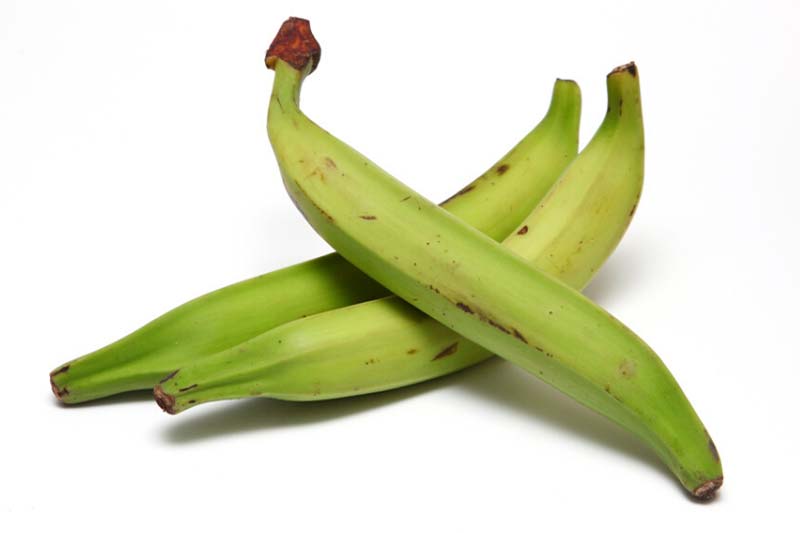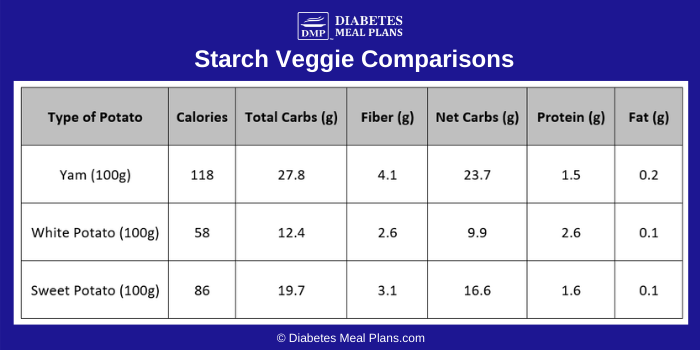Plantains are a starchy fruit with some interesting benefits and drawbacks when it comes to type 2 diabetes.
Depending on where you live, you might not even be familiar with plantains and their nutrition, but it’s important to know about every food you may encounter and how eating that food would potentially affect your health.
So, without further ado, let’s get to know these funky fruits called plantains…

What are Plantains?
Plantains, also known as ‘cooking bananas’ or ‘green bananas’, are fruit from the genus Musa sp paradisiaca.
Yep that biological name is quite a mouthful but in short, plantains are a plant in the banana family.
They are larger than a regular banana is and they have a tough skin that’s much harder to peel.
Unlike a banana, plantains are typically eaten cooked and used in a lot of savory dishes. They are not as sweet as a banana but do become sweeter as they ripen.
Plantains are a dietary staple in Africa, Central America, coastal South America, and the Caribbean islands. In these regions plantains are often served as fried chips, cut into thick slices, or cooked through boiling.
A green plantain is very firm and the pale yellow inside must be cooked in order to be eaten. Cooked plantains taste more like a potato than a sweet banana, which is why they are used in many savory meals.
As a plantain ripens, its color changes, turning yellow. Eventually the outside will turn almost entirely black and become much softer.
The skin becomes easier to peel and it tastes sweeter, which is closer to a traditional banana. Because of this, ripe plantains can be eaten raw, but in the cultures where they are most popular they are still usually cooked.
Plantain Nutrition Facts
One cup of sliced yellow (ripe) plantains contains:
- Calories: 180
- Carbs: 47 g
- Fiber: 2.5 g
- Protein: 2 g
- Fat: 0.5 g
Plantains are a good source of vitamin A, vitamin C, and B-6, as well as the minerals potassium and magnesium.
Green plantains are also rich in resistant starch, a type of fiber that benefits gut health. However, be mindful that plantains are a high carbohydrate food, therefore, we do not encourage them as part of a low carbohydrate diet.
The glycemic index of plantains ranges from 39-90 depending on if the plantain is yellow or green. A green plantain will have a lower glycemic index (39-41) than a yellow plantain (66-90).
Typically you want to choose foods with a glycemic index of <50 to help decrease the glycemic response. But with that in mind there are many other factors that can affect a food’s glycemic response, such as different cooking methods and the other foods your eating with it.
And again, regardless of a food’s glycemic index, all those carbs still end up in your bloodstream one way or another.
Speaking of which, let’s see just how many carbs are in a few different kinds of plantains and plantain products.
Comparing Plantain Nutrition
As we mentioned earlier, ripe yellow plantains are much sweeter than green plantains. This difference is reflected in the amount of carbs (sugars) present in each fruit.
Take a look at this chart and compare the total carbs and net carbs in the yellow and green plantains.
The green plantains have slightly fewer net carbs than the yellow plantains do (although 36.4 g of net carbs is still nothing to mess around with).
The problem with plantains is that, like bananas, they don’t have nearly enough fiber to offset the amount of carbs. This means that the glucose will rush straight into the bloodstream and may cause a blood sugar spike, which is the opposite of the blood sugar stability you’re trying to achieve.

Another item on the chart are plantain chips.
Plantain chips are a food item that has gained a lot of popularity in the health-food arena as a “healthier” alternative to potato chips. But are they actually healthier for people with type 2 diabetes?
Looking at the nutrition profile of plantain chips, a one-ounce serving contains about 16 grams of carbohydrates, which is even more than a same-sized serving of potato chips.
What this means is that for people with type 2 diabetes or prediabetes is that they’re actually are a less healthy option than potato chips!
Not that we recommend either of them; processed foods in general are better left unconsumed.
A final plantain-based product for consideration is plantain flour.
Plantain flour is a gluten-free alternative to regular flour, but it still contains a hefty amount of carbohydrates.
One quarter-cup of plantain flour contains about 30 grams of carbohydrates and only 2 grams of fiber. One quarter-cup cup of whole wheat flour contains 22 grams of carbohydrates and 3.65 grams of fiber.
Again, the whole wheat flour wins over the plantain flour in terms of nutrition.
Even better is a low-carb flour like almond flour, which wins with just 12g of net carbs per 1 cup.

Research on Plantains and Type 2 Diabetes
The one major positive point when it comes to plantains is that they contain resistant starch.
Resistant starches resist digestion as they pass through the gastrointestinal tract, and they end up in the colon where they “feed” your friendly gut bacteria.
Some human studies show that resistant starch may help improve insulin sensitivity, lower blood sugar levels, reduced appetite, and improve digestion.
But it’s important to note that the benefits of resistant starch depend on the individual who’s eat it, the dose, and the type of resistant starch. The studies investigating its impact on glucose control and insulin sensitivity are mixed, with some studies showing no benefit.
Resistant starch may also have a “second meal effect”, meaning that if you eat resistant starch with breakfast, it may lower a potential blood sugar spike at lunch.
Animal studies have also demonstrated that resistant starch may have positive impact on overall glycemic control.
However, it is important that you keep in mind—while resistant starch may offer some health benefits, the high amount of carbohydrates in plantain may push blood sugar levels up, which does not improve diabetes in any way.
Another thing to remember is that the content of resistant starch in food is highly impacted by food preparation and processing. If you want to get the highest amount of resistant starch from a plantain, choose plantains that are unripe and after cooking them, allow them to cool completely before eating, even if you reheat them.
Conclusion
Overall, plantains are a nutritious fruit that contain resistant starch, which may have a positive impact on blood glucose and insulin sensitivity.
However, the fact remains that plantains contain a large amount of carbohydrates for someone following a low carbohydrate diet.
The stage of ripeness of a plantain, how it is cooked and prepared, and what it is eaten alongside will influence the amount of net carbs it contains and the glycemic response.
Items such as plantains chips and plantain flour are popular in the health food scene but these products still contain a large amount of carbohydrates and are not healthy options for people with diabetes.
It is best to avoid consuming plantains on a regular basis if you have diabetes.
For a sweet treat instead of plantain, try fresh berries or a delicious low carb dessert!
Trade out plantains in a savory dish for a low carb substitute that mimics the taste and texture of starchy vegetables: cauliflower.

Leave a Reply